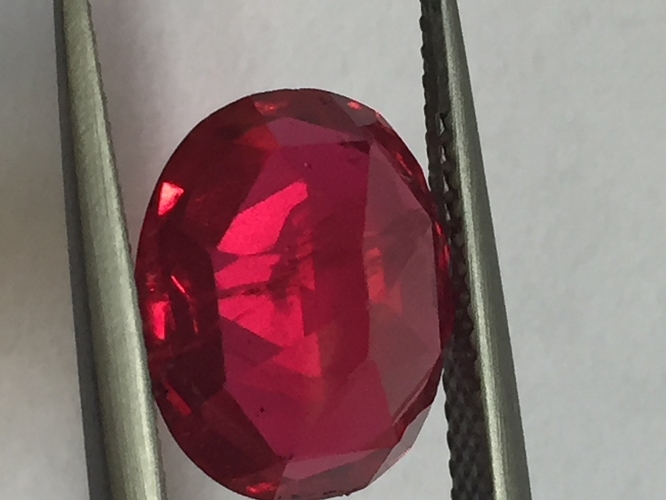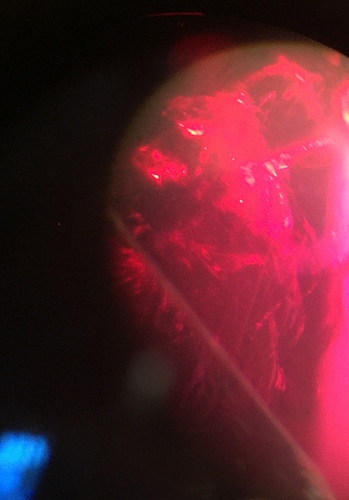I do intend to have this gem assessed but before I spend the money I’m trying to get a better understanding of feather inclusions in ruby.
Despite high resolution microscope viewing I can’t find evidence of curved striae or gas bubbles or flux residue. What I have is a significant feather inclusion which is not surface reaching. I don’t believe they were creating “quench cracked synthetic ruby” 30 odd years ago (this is an old gem) but perhaps the feather was created by an accidental heat application at some point in time? Thoughts welcomed.
IDK about quench cracked, etc., but Caroll Chatham died in 1983 and created the Chatham synthetic ruby well before that, altho’ I’m not sure of the exact date. Not striae or bubbles in those…so it isn’t clear that this is natural and given the prices for slightly included natural ruby, you’d have to consider that it could be Chatham synthetic. Ramaura began production in 1983 and some of those do have fractures and healed fractures in addition to fingerprint inclusions. Kashan started before 1983, too, I think, but I can’t find any data on those right now.
You might try to get hold of a copy of “Photoatlas of Gemstone Inclusions” by Gubelin and Koivula through interlibrary loan (it is three volumes… start with Vol I)…somewhere in there are photos of natural and synthetic gemstone inclusions. Or just give up and get it appraised…if it turns out to be natural it’s an awfully nice stone and well worth appraising. IDK what the going rate for premium synthetics is right now, but probably $300/ct retail in a two carat size…
royjohn
Thank you. I didn’t think of the earlier Chatham synthetic. Yes, that will require an expert to differentiate. It’s a big stone, 6.19 carats. Seeing as AGL charge quite a lot for a full report I was hesitant to be spending close to $500 Australian (plus another $100 shipping) on what might be a synthetic worth $10. Plus the embarrassment! I’m a trainee Gemologist but even with all the normal testing (except microscope basically) you can’t really distinguish between natural and synthetic. Others that came with the lot are natural rubies, coming with much easier inclusions to ID!
Hi Bron,
It is just this problem that kept me from becoming a full time appraiser. I know that to do the job right I would need experience with many, many synthetics and the only place local I could acquire such at that time (we’re talking 20+ years ago) was a local appraiser of questionable ethics. So I settled for cutting and dealing, where I can pass on what I can’t identify. If you studied the first two volumes of Gubelin and Koivula religiously and looked at a fair number of stones, you could probably crack this problem. If you cant decide, you can always tell folks it has to be sent off to GIA or your local equivalent. Those two volumes would cost you about $250 each, I think. I’m not sure if the info is available on line. Someone sent me a site back a while ago, but I can’t remember if it was for emeralds only or included other stones. I will have to try to hunt up the website citation.
Yes, if there aren’t any diagnostic inclusions, you could be stumped, which is why some natural inclusions, esp. if small, can be an advantage in a natural ruby. I would think there might be a good appraiser local to you who could solve this problem, but I can’t say for sure. You could query your local sources or the nearest gem lab as to who they recommend in your area. Or a local appraisal accreditation association. There should be a difference between that feather in natural and synthetic, and then there’s also magnification and 30 to 60X might turn up something you’re not seeing. I haven’t checked all my books, so there may be some methods to distinguish natural from those premium synthetics…some of the synthetics used to put a doping agent in that led to fluorescence or something…I am leaning synthetic just because it is so big and so clean and such a nice red, but if it is real it is quite a find, price could be $6000-$9000/ct!
Good Luck,
royjohn
Hi again, Bronwyn and all,
The site I was thinking of is <www.geminterest.com>. It is in French, but you should be able to make out what you need to with the help of our good friend Google Translate, which is right most of the time. There is a box on the left near the top on the home page which shows that there are 1491 pictures of gem inclusions. If you click on this inclusions link it brings up the inclusions page and the list of gems. If you click on a gem, you get photos of inclusions for that gem. There are many photos of inclusions in Ramaura, Kashan, etc., rubies and I expect also for natural. This would be a good place to start and maybe you can distinguish your feather.
Another piece of advice I got over on gemology on line was:
“With immersion, natural mineral inclusions will go light to dark as you rotate the stone. Solid inclusions typically found in synthetics will remain dark in all directions.” Perhaps this will help. Immersion is helpful, whereas darkfield, so useful for diamonds, can be confusing with colored stones. I don’t remember hearing this in my gemology training. Maybe I missed it.
You might find other useful info on the gemology on line forum, where a lot of the big gemologists hang out, including my hero, Bill Hanneman.
Again, good luck! You need to buy me a beer if it turns out to be natural! If it’s synthetic I’ll buy the beer and watch you cry in it!
royjohn
RoyJohn, thank you. Sit down with a beer and I’ll tell you a story.
Driving home from Grocery shopping and traveling through an exclusive area in Sydney, I spotted an “on site” auction sign. Not unusual here, once the relatives have frisked the house, anything left over usually goes in a rubbish skip, but if at all saleable, they will do an “on site, clear the complete house” auction to raise a few bucks (because it costs money to dump stuff).
I actually wanted to check out the house. It was a historic Federation (and it sold for $5 million bucks). So inside we go.
Typical old lady living in an old house type fare. All the good stuff already taken by the beneficiaries but still interesting stuff. In a bedroom on a bed was a battered cardboard box, apparently found in the bottom of a wardrobe and full of small metal tins, lots of them. Rusted shut. Plus old jewellery drill bits, old fashioned jewellers scales, what I thought were silver findings (ring heads, earring backs, clasps). Also some uncut small sapphire, raw turquoise slabs, loose pearls, loose coral beads, loose garnet beads.
What a strange thing to find, weird but interesting. Eek, dead creatures also in this box. Ugh, anyhow I do some jewellery making and I figured I could use the beads and silver findings. $60, it’s mine.
At home I’m rattling these tins, what’s inside? I look at the jewellery bits. What, I’m seeing 18ct, 750, Plat. Not silver- score.
Low and behold as I finally get tins open I see lots and lots of “crystals”. Excellent. I pick up a nice yellow one, hang on, this ain’t no crystal, this is a yellow sapphire. What, how is this possible?
I did some research. Sure Mrs more recently passed away, but hubby died in the 1990s. With his name I googled it, sure enough a jeweller and he must have done ok enough to afford the ritzy house.
I’m figuring he had stuff at home, when he suddenly passed (heart attack apparently) it looks like Mrs just gathered up all the odds and ends from his home workshop, put them in a box and then put them in the wardrobe and there they stayed. And then forgotten.
This is one of them. Most others were easier to ID but rubies are hard.
So a treasure trove and 58 grams of gold & Plat for $60.
No tears here. Cheers
1 Like
Flame fusion synthetic ruby production started in the late 1890’s, so quench crackled synthetics date back long before your 30 years estimate.
Jeffrey makes a good point, but any synthetic ruby can be quench crackled. Just heat it up and drop it into room temperature water. I made my own some years ago using one of those old hydrothermals Jeffrey is talking about. A quench cracked stone looks crack-aled not feathered.
RWW
Thanks for your comments. I have been unable to find any inclusions that would indicate synthetic but I appreciate that it can be extremely difficult to sort good synthetics from natural. I have viewed many photos of quench cracked synthetics and mine is different. I will send it to a lab for assessment, I was just trying to be somewhat “more sure” before outlaying the $$$. Cheers.
Please excuse my awful photo (just my phone sort of looking down the microscope) these are the feathers.
I had a thought, Quench-Crackled Dyed Quartz Could this idea be taken to the next level using (Al2 O3) and the magic amount of (Cr) AkA flame fusion synthetic ruby and the “dye” could be seeds for inclusions .The whole boule could be done at one time then refused in a a high temperature vacuum/inert gas furnace . These furnaces can reach 2200 C and under very high vacuum . With computer control the ramp and soak times could be set to give just the right amount of refused cracks or feathers left . Any one have a phase diagram for corundum . This is starting to sound like a episode of Braking Bad sorry bad pun.

